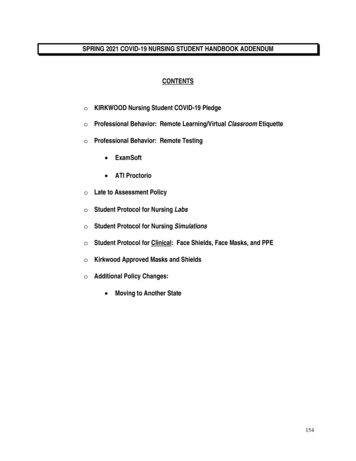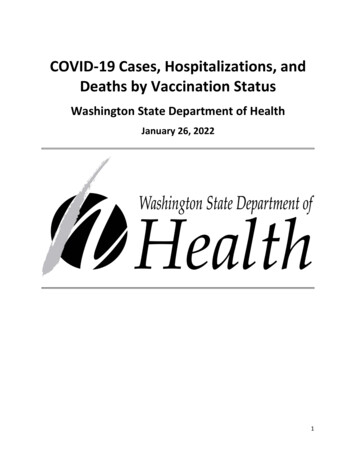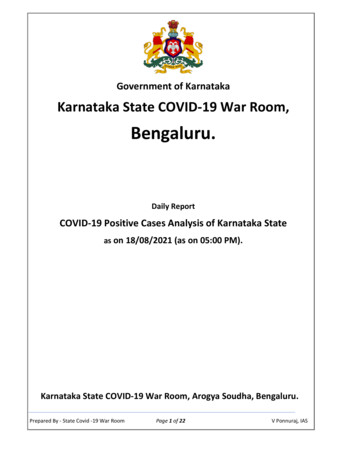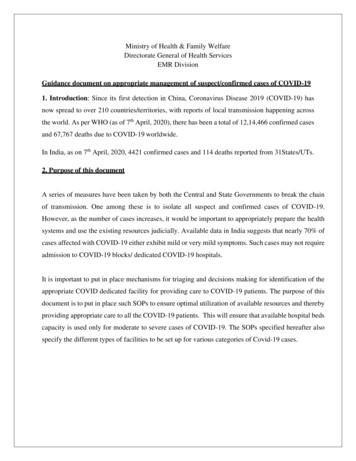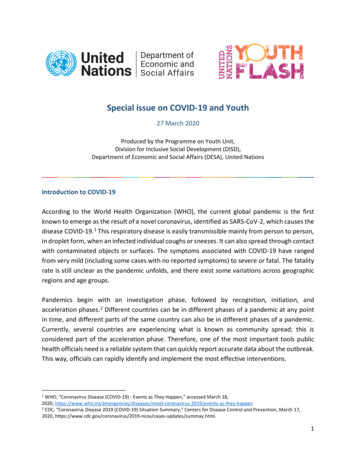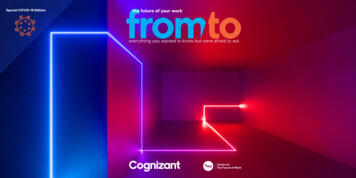
Transcription
Special COVID-19 Editionthe future of your workeverything you wanted to know but were afraid to ask
The Future of Work Is Now the Present of WorkIn the summer of 2019, we published a major report, From/To: Everything You Wanted to KnowAbout the Future of Your Work But Were Afraid to Ask, that described “a state of the union for thefuture of work.” In it, we examined 42 trends – ranging across technology, demographics, culture,business models and collaboration styles – that we argued will be important for anyone interestedin the future of their work.Fast-forward to the summer of 2020. Many of these trendsno longer represent the future of work but are entirely centralto the present of work. Working remotely, working on acouch, wearing a hoodie, leveraging the cloud, collaboratingover video, using AI-based solutions, talking to technology,worrying about privacy, fretting about always being “on” –things that had seemed on the edge of many people’s radarsa mere 12 months ago are now, as a result of the COVID-19pandemic, right bang in the middle of them.As a result, it’s probably time to amend one of the most oftquoted observations about the future from science fictionwriter William Gibson: “The future is here. It’s just unevenlydistributed.” Instead, it looks like the future is here; it’s justmuch more evenly distributed.This special edition of From/To is a snapshot of howmillions of people around the world are living andworking today – and for the foreseeable future –as a result of the COVID-19 pandemic.We’ve taken 21 of the 42 ideas from our original reportand updated them for our strange current times.In this Special COVID-19 Edition of From/To, we’ve selected21 of the 42 ideas from our original report and updated themfor our strange current times. (The other 21 ideas remainsomeway away in the future. )We’ve maintained the architecture of the 2019 report,keeping its five main chapters: The Way We Work: How we do what we do. The Tools of Work: The apps, systems, networks, toolsand processes that we use to work. The Issues with Work: When and why work is work. The Meaning of Work: What gets us out of bed andmakes us proud.We’ve also kept the original report’s format and structure:“From” describes where we are, and “to” describes wherewe’re going. But the “to” is now not off in 2023 or 2027 butvisible right in front of us in this year of our Lord, 2020.As we noted in the introduction of the original report, theFrench writer Simone de Beauvoir once wrote that, “To makesomething good of the future, you have to look the present inthe face.” Those words seem eerily prescient now, as we dealwith the biggest existential threat to our way of life – and wayof work – since the ending of the Second World War.It is safe to say that although the future of work is always,by definition, in the future, the future of work that we atCognizant’s Center for the Future of Work have beenanalyzing and evangelizing for close to 10 years is nowsomething that everyone needs to be paying attention to.Whether they like it or not.This Special COVID-19 Edition of From/To is not a fieldguide to the future, as we characterized the original report.It is snapshot of how millions of people around the world areliving – and working – today. And for the foreseeable future. The Aesthetics of Work: What work looks like;how it feels.From/To: The future of your work — everything you wanted to know but were afraid to ask Special COVID-19 Edition / 2
IndexThe Way We WorkThe Tools of WorkThe Aesthetics of WorkThe Issues with WorkThe Meaning of WorkHow we do what we doThe apps, systems, networks, tools andprocesses that we use to workWhat work looks like; how it feelsWhen and why work is workWhat gets us out of bedand makes us proud6From 8x5 to 10x410From the Thumb to the Voice16From the Suit to the Hoodie21From Free WiFi to WiFi Free247From PAs to RPAs11From Microscopes to Datascopes17From the Cubicle to the Couch228From Buying to Leasing12From Insecurity to Security18From Glass and Steel to Bricks and WoodFrom Privacy Is Dead to LongLive PrivacyFrom Mind Your Language toSpeak Your Mind25From Career to Careers13From 4G to 5G19From Originals to Digit-alls26From Green Is Red to Green Is Green14From Centralized to Decentralized27From Mass-Produced to Me-Produced28From Retired to ‘Re-Tired’29From CEO to She-EO30 From Diversity to Belonging31Endnotes32About the AuthorsFrom/To: The future of your work — everything you wanted to know but were afraid to ask Special COVID-19 Edition / 3
50% of theFuture of WorkIs Here Right NowFrom/To: The future of your work — everything you wanted to know but were afraid to ask Special COVID-19 Edition / 4
thewaywework
THE WAY WE WORKFrom 8x5to 10x4The 40-hour, five-day work week is a product of the First IndustrialRevolution.THE ELEVATOR PITCH:The working week isdead. Long live theworking week.Robert Owen, one of the 19th century founders of the cooperative movement, marketedhis radical idea of ending the excessive, abusive work practices of the day with the slogan,“Eight hours’ labor, eight hours’ recreation, eight hours’ rest.”So successful was Owen’s campaign that the notion of a standard working week hasbecome ingrained in our concept of what work fundamentally is. The working week is fivedays – 9 to 5, Monday to Friday, followed by a weekend. This seems so platonically rightthat those who don’t work to this rhythm seem to operate in an odd netherworld thatdoesn’t smell quite right. We sort of feel sorry for the nurse on the nightshift; we’d look atsomeone who chose to work from 2 pm to 10 pm and took Wednesday and Thursday offas a bit of a weirdo.So normal is the “9 to 5” that we can all hum the song, and most British people of acertain age know that “a Mars a day helps you work, rest and play.” (Owen’s utopian dreamreduced to a slogan of capitalism; how ironic.) Forty hours as the standard unit of humanlabor was further solidified by the “commute” – another product of the First IndustrialRevolution; “going to work” literally implies work is elsewhere. If the commute eats into“our” 16 hours, then work better stay in “its” eight hours. In its five days.BACK TO INDEXBut now, in the midst of this grand work-from-home experimentthe world is experiencing, work is everywhere and anywhere andall the time – when we’re at our desk and in the socially distancedcheckout line. In the conference room we hope to soon be backto, and in the bleacher seat watching our kids play sports – anexperience we all so desperately hope is not gone forever.THE BOTTOM LINE:Every weekend shouldbe a long weekend.Since the beginning of the latest industrial revolution but particularly now, many of usnow work “5 to 9” (am to pm), checking email first thing in the morning and last thingat night – in bed.Work is literally and metaphorically in the palm of our hands. Unchained from aphysical place and a punch clock, we no longer go to work (“on time”) at all – workcomes to us, at all hours of the day. This diffusion of work – away from the factory,away from the office – breaks the very idea of a standard unit of human labor.But yet, the 40-hour work week is still so deeply embedded in our sense of thecontract between employer and employee that abandoning it altogether feels anunnatural act. The compromise emerging – that recognizes the fluidity of work butalso the need to stop it from eating us alive – is the four-day week. Ten hours a day,four days a week. Some structure, but more time unplugged. The digital Sabbath(Friday naturally) is all the rage. /BPFrom/To: The future of your work — everything you wanted to know but were afraid to ask Special COVID-19 Edition / 6
THE WAY WE WORKFrom PAsto RPAsTHE ELEVATOR PITCH:Robots won’t stealyour job; their helpwill make it waybetter.From the king’s retinue 1,000 years ago to the loyal butler Mr. Carsonin Downton Abbey – assistants have always made work easier for us.Rather than preserving this status quo, we should liberate individualsto do more fulfilling, more enjoyable, more lucrative work.After 1950, every executive from Mad Men’s Don Draper to MI6’s James Bond had apersonal assistant.In short, your new PA will be an RPA: a robotic personal assistant. The term “RPA”can convey the wrong impression; Robby the Robot or “the Borg” aren’t runningaround the office – yet. Still, “Beat the bot!” remains a battle cry across wide swaths ofworkers.But by 2000, Microsoft Office made office typing pools, secretaries and personalassistants redundant. Individuals did their own scheduling, typing and printing. Costcutting contributed to this trend, but for senior executives back then, getting access to alocal-area network and an email address to “do it yourself!” seemed cool. Who needed aPA when you had a PC?The tradeoff for the “department of do-it-yourself” was, of course, extreme inefficiency.The amount of time you can spend booking travel, doing expenses, getting apresentation template or obtaining a factoid on your corporate intranet is a time-suck.Instead of “Welcome to the future of work,” too often it’s, “Welcome to the officeintranet – your password was denied.”Increment by increment, critical time for thinking strategically gets whittled into30-minute buckets on your Outlook calendar.And yet we use Siri, Alexa and GPS tools today – they’re all essentially roboticpersonal assistants. Imagine going from LaGuardia Airport to Newark and crossingmidtown Manhattan during rush hour to catch a connecting flight. Would you evertry this (and catch your flight, on-time) without using GPS?THE BOTTOM LINE:Your new favoriteassistant at work willbe fueled by ones andzeros, not coffee.Marvel’s J.A.R.V.I.S. didn’t wait for an email to save Iron Man – he predicted needs.As “bots not apps” gathers momentum, a J.A.R.V.I.S-like robotic personal assistantaggregating software layer – with voice as the default interface – will emerge asthe dominant model. Already, robotic assistants like Google’s Duplex voice bot (forreservations) and x.ai’s Amy Ingram (for scheduling meetings) are yielding hugeproductivity and creativity gains.When we recently asked over 2,000 senior leaders what skills they need in five years,without exception, every skill was a human skill – and they needed an average of 15%more of all of them. So why doesn’t every doctor, lawyer, teacher or rental car agentstart using robotic personal assistants to “find their 15%”?1To beat the robots, we’ll need to join them. Robotic personal assistants will help buyback at least that 15% capacity (or more) needed for the skills of tomorrow. /RBBACK TO INDEXFrom/To: The future of your work — everything you wanted to know but were afraid to ask Special COVID-19 Edition / 7
THE WAY WE WORKFrom Buyingto LeasingOwnership has long been a bedrock of the modern world.THE ELEVATOR PITCH:The cost ofownership exceedsthe point ofownership.Our house, our car, our land. Ownership is the marker of affluence and success for manyin Western society. Think of the joy you experienced when you bought your first car (nomatter what condition). Or the pride and trepidation you felt when receiving the keys toyour first mortgaged home. These are milestones in many individuals’ lives that give thema measure of achievement.Car ownership is often the first signpost on the journey to adulthood and represents ataste of true adult independence. Walk down any suburban street to see how this hasplayed out – driveways and garages packed with cars.Of course, the car is just one indicator of obsession with ownership; Western consumerbased economies have traditionally fetishized the need to own things – watches,paintings, koi carp, houses, software. If you’re not buying and conspicuously displayingyour trophies, you’re either moderately poor, extraordinarily rich or simply not playing thegame. In the immediate wake of 9/11, President Bush extolled us all to go shopping. Tobuy and own things.However, the tide has shifted, and our current lockdown limbo andimpending economic depression has and will continue to cast astark light on our consumer-driven behaviors of old.Buyers are questioning, why spend 40,000 on something that sits idle for 23 hoursa day? Why buy a 1,000 suit to only wear it four times a year? Why strain my financesto rent office space in Manhattan when Remotopia is the new normal? Why spend thetime and trouble running my own servers? It used to be that these things made sense.There was no alternative. But increasingly now there is, and they don’t.When I need a car, I book it on my Zipcar app. When I need to look sharp, I clickon Rent the Runway. When I need more space, I speak to my WeWork communitymanager. When I need an extra terabyte, I click an API.THE BOTTOM LINE:The linkage betweenownership and wealthis withering. Soon it willbe broken.For a generation of consumers who will never be able to afford their own home,thanks to the house-price-inflation/pass-the-parcel game their parents have played,not to mention today’s economic uncertainty, this model will become increasinglyattractive – indeed the norm. Ownership is becoming a bug in late-stage Westerncapitalism, not a feature.While many might question how quickly this cultural step change will play out,remember that in addition to the seismic shift we’re experiencing today, the movefrom physical maps to Google Maps, from snail mail to email, and from cable toNetflix happened in the literal blink of an eye. Keep yours open. /MCBACK TO INDEXFrom/To: The future of your work — everything you wanted to know but were afraid to ask Special COVID-19 Edition / 8
thetoolsofworkFrom/To: The future of your work — everything you wanted to know but were afraid to ask Special COVID-19 Edition / 9
THE TOOLS OF WORKFrom theThumbto the VoiceThe graphical user interface innovations of Xerox in the late 1970sgave birth to the mouse, which combined with the keyboard tobecome the ultimate tag team in computing.THE ELEVATOR PITCH:This may be thedigital age, butdigits are becomingsuperfluous.We’ve been tapping keys, clicking and scrolling ever since. With the rise of smartphones30 years later, those inputs gave way to thumbs furiously typing and swiping ontouchscreens. As phones grew ubiquitous, touchscreen interfaces expanded to ourcars, restaurants, banks and any other instance that calls for digital interaction. Theintuitive design of touchscreens enabled computer literacy for young and old, as well asunprecedented mobility and accessibility to computing – so much so that the rest of ourlives began to bend to the will of it.As a result of our phone addictions, “sore thumbs” don’t stick out at all anymore. Painand stiffness of the thumb has become a fact of life for some and a recurring nuisancefor others. Our vision is worsening, and our posture grows more hunched and stoopedby the day. The hand-eye coordination required to use touchscreens prevents us fromengaging in other activities while using them. After a decade of zooming, pinching andswiping right, the future of computers calls for a resounding thumbs down on thesetactile interfaces.BACK TO INDEXDid you ever see Captain Kirk type?Of course not! He just talked to the computer. In our unending search for convenience,the clickable interface is old hat, replaced by voice-activated interactions withdevices that listen to us, enabling operations without touching or even looking atthem. Personal home assistants led the charge of voice-activated appliances, butthe technology is swiftly expanding to all manner of devices. Mics are now tinierand cheaper than ever. Voice processing technology is steadily improving. Themost advanced systems are able to discern specific voices amid the cacophony of acrowded room.THE BOTTOM LINE:The winds of changeare blowing, and yourdevices hear it all.Major appliance makers already tout their intentions to fashion all their products withmicrophones. Voice UX designers will need to forge the path forward by designinginterfaces that account for accents, colloquialisms, differing languages and all theother idiosyncrasies of the human voice.Fully shifting to a screenless, touchless future will return our attention to thingsthat matter most and reinstate a modicum of safety to activities like driving. Thetechnology is of particular use in the post-COVID-19 climate, where touchingunsanitized surfaces poses a great threat to a more hygiene-conscious populace. Butwhat does a world of always-on microphones sound like? Ubiquitous voice activationfurther erodes any sense of privacy remaining from the smartphone era. No need towhip out your phone and hit “record” when the refrigerator is already fixated on everyuttered word. Now if a tree falls in the forest and nobody hears it, we’ll just ask Alexa ifit actually happened and what it sounded like. /DDFrom/To: The future of your work — everything you wanted to know but were afraid to ask Special COVID-19 Edition / 10
THE TOOLS OF WORKFromMicroscopestoDatascopesIn 1831, Manchester Royal Infirmary in the UK used 50,000 leechesper year to treat ill citizens of the first great industrial city.THE ELEVATOR PITCH:Just as microscopeschanged medicine,AI is a “datascope”that will give newinsight to solutionspreviously thoughtunimaginable.Twenty years later, John Leonard Riddell of Tulane University invented the first practicalbinocular microscope. By 1930, Manchester Royal Infirmary finally closed its leechaquarium.Why? Riddell’s technology allowed doctors to see – at a cellular level – what was trulycausing the problem. A microscope could detect the bacteria causing illnesses liketuberculosis, an intestinal infection that would lead to cholera, a cell mutating into acancer. The medical microscope not only made the leech redundant but also created anindustry that today employs millions of people around the world, and in the process madethe world a better place.In the transformation from leeches to microscopes, did Riddell destroy anyone’s job? Yes,probably. But microscopes were central to the explosive growth of healthcare that led tothe population and economic growth that made the modern world.Nobody today would argue that we should have stayed in a leech-based paradigm. Ofcourse, if your current business model is a modern version of leech breeding or retailing,then AI is bad news. You may be able to eke out a living for a generation or two, as leechmagnates did until 1930, but nobody mourned their passing, and nobody will mourn thepassing of their modern equivalents.BACK TO INDEXJust as Dr. Riddell’s microscope yielded new things to do, our newAI tools will function as “datascopes” – in medicine and every otherindustry – allowing businesses to see more data, integrate it withother data and make decisions faster than ever before.The next generation of lawyers will likely argue that doctors who don’t use AI toolsare guilty of medical malpractice.2 In another generation, using non-AI-infusedtechnology will seem as anachronistic as using leeches does today.AI will allow radiologists to see more data (e.g., pixel biopsies), integrate that withother information sources (“multilayered data” in medical parlance) and make fasterdecisions. This approach is also transferable to many more disciplines and businessprocesses.Think of AI not just as a tool that reduces the labor component of a process, but alsoas a means to increase the overall scale of the process. AI will allow us to grapple witha world awash with information that is denser, more complex and coming at us fasterthan ever before. The search for a COVID-19 vaccine will make the use of datascopeseven more important. AI will open new opportunities for commercial growth andlevels of employment for billions, and make the world a better place. /BPTHE BOTTOM LINE:New tools don’t just“automate peopleaway;” they allowpeople to do thingsthey’ve never beenable to do before.From/To: The future of your work — everything you wanted to know but were afraid to ask Special COVID-19 Edition / 11
THE TOOLS OF WORKFromInsecurityto SecurityWe are on the cusp of a “great digital buildout,” in which technologybecomes embedded in, and central to, every aspect of modern society.THE ELEVATOR PITCH:The future of workrests on flimsyfoundations.This wave of development rests, though, on one fundamental assumption: that thetechnology on which the future is built is safe.One would have to be a very good advocate to argue that today. The 2016 U.S. electionwas hacked. Pentagon satellites have been hacked. North Korea’s missile launch programis repeatedly hacked. Film studios are forced to pay ransoms to stop criminals releasingmovies before their official launch. Pacemakers are hacked. Cars – both of the humandriven and autonomous variety – are hacked. It is clear that the computer technology weare using today is entirely unsafe.Fortunes and fates rest on the flimsiest of foundations; even the bluest of blue-chipcorporations (and the most deep-pocketed) admit (off the record) that they have been(and continue to be) repeatedly hacked. Our ability to function amid this truth stems fromour individual and collective ability to ignore and deny it.Personally, most of us take comfort in “security through obscurity.” Collectively, most of ustake comfort in, “That’s John – or Vivek’s – problem, not mine.” No one and nothing isreally safe. If you’re wondering if you’ve been hacked, you probably have been.BACK TO INDEXAs Aaron Levie, CEO of Box, put it, “If you want a job in five years,study computer science. If you want a job for life, study computersecurity.”Making our connected homes, buildings, planes, operating theaters, parliaments,bank vaults, classrooms and virtual reality environments safe and secure is themost important (and limitless) job of the future. Something even more urgent –the pandemic-induced rush to get everything online – has created a hacker’s fieldday. How do we secure it all? Well, start by taking your cybersecurity budget andquadrupling it.You may think you’re spending a lot of money already, but you’re not. Large banksspend hundreds of millions of dollars on cybersecurity – which sounds good – butin truth, those amounts are typically less than 1% of their entire IT budget (which inturn are typically less than 10% of annual revenues). Given that market capitalizationsof hundreds of billions of dollars rest on these foundations, this makes no sense.THE BOTTOM LINE:You can’t spendenough oncybersecurity;quadrupling yourcurrent numberis a start.Unless you’re long on pigeons and Faraday cages (or your play is simply to have ahigh-end crisis management firm on retainer) you have no choice but to upgradeyour cyber defense. Next step: Ask your local friendly Mossad agent for the contactinfo of one of the leading Israeli service providers and arrange an after-hours salescall. You’ll be horrified by what they tell you (from an exposure and remedial costperspective), but a drop of prevention is still worth an ounce of cure. As it is, the futureof your work rests on quicksand. You need some graphene rebars pronto. /BPFrom/To: The future of your work — everything you wanted to know but were afraid to ask Special COVID-19 Edition / 12
THE TOOLS OF WORKFrom 4Gto 5GThe higher the G, the faster the connection.THE ELEVATOR PITCH:The latest bandwidthspectrum will be thenext phase of thedigital revolution.BACK TO INDEX1G phones let us talk to each other on the move, 2G phones let us send messages, 3Ggave us the mobile internet, and 4G made it a whole lot faster. We use 4G networksto stream music, listen to podcasts and watch live TV on the commute home – allunthinkable 10 years ago. Even the simple Facetime app that beams cousin Susan inNew Zealand onto your phone? Impossible until the arrival of 4G.The advent of 5G massively accelerates the data transmissionspeeds generated from a 4G network.5G networks will be 10 times faster than today’s cable internet, and 100 times fasterthan our current 4G phones. Imagine streaming your favorite Netflix movie in HD toyour phone vs. streaming 400 of your favorite moves in 8K (16 times the resolution ofHD) all at the same time. 4G connectivity gave so much, but more is to come.The promise of blazing-fast data transmission speeds 10 times faster than 3G is thereason we addictively watch, tap, poke, pinch or swipe our smartphones as much as wedo. Beyond the consumer experience, businesses understand the benefits of 4G. Thespeed of decision making in the field means much higher rates of productivity acrossdepartments, with sales, customer service or logistics citing the financial benefits fromalways-on connectivity at 4G speeds.5G supercharges every action, device or place with zero-lag interactivity. Brace fora wave of innovation as 5G data fuses with machine learning and sparks a world ofincredible possibilities. Real-time interactions and synchronous processing will runwith no lag whatsoever. The data transmission and its interpretation will happeninstantaneously – you won’t just see cousin Susan on a screen; you’ll be sitting nextto her avatar, in a shared virtual home and watch her speak.For those who can remember the hiss of a dial-up modem, 4G speeds have beenastonishing. But in time, G’s 4 through 1 will come to be regarded as quaintly as theFlying Scotsman train was in the middle of the aeronautical age.Imagine putting on your headset and driving a car, administering medical care orpiloting a train as you sit on the other side of the country. You could be a farmer forthe 21st century, commandeering a fleet of drones and soaring over the plains of theAmerican Midwest, using sensors on the ground to sort, pick, feed and water everysingle individual plant. 5G will usher in a revolution in how value is created and howwork gets done. /EDTHE BOTTOM LINE:Fusing 5G with AIsuperscales theInternet of Things.From/To: The future of your work — everything you wanted to know but were afraid to ask Special COVID-19 Edition / 13
THE TOOLS OF WORKFromCentralizedtoDecentralizedTHE ELEVATOR PITCH:In the wake ofthe internet, newplatforms threatendisruption, butdecentralization willhelp the centerto hold.Modern technology gave people, businesses and societies tools forgreater centralization and (especially) control.Decentralized expressions of free will, hope and trust are whatmake liberal democracies – and confidence in commerce – work.But centralized anything – whether bureaucracies, governments, planning orgovernance – is often disjointed at best, and disruptive at worst.And without them, the digital economy will fall apart.Take the advent of ERP software: It promised to connect “islands of information.” Butwith the elongated timelines to meet such ambitions, the initiatives tended to fall short oftheir intended benefits. And breaking that rigid, centralized legacy became tough in theaftermath.Meanwhile the internet appeared, and sought to decentralize and open everything, be itin business, society or government. It’s 2020. Look around. You’ve never been surroundedby more technology. But has it bred optimism – or just “optimization?” How do your coworkers or neighbors – or you – feel about it?At work, LinkedIn became the de facto org chart, but it also opened an escape hatch forthe departure of great talent. At home, the family reunion’s now on Facebook, but so areUncle John’s divisive politics. At city hall, Twitter keeps constituents informed of potholesbut also blows up into vitriol and corrosive comments.Nobody – yet – has gotten a handle on how to respond to the speed, intensity andbreadth of change spawned by these digital usurpers. When the inability to respondis compromised, resilience is too. And when businesses, societies or individuals aren’tresilient, you get “disruptions” and even outright chaos.BACK TO INDEXAmazon, Netflix and Zoom succeed because of their convenience and/or costeffectiveness. They also eliminate intermediaries. Peer-to-peer platforms likeTransferWise for currency exchange, or GitHub for sharing computer code, arefollowing a similar trajectory.Meanwhile, blockchain may infiltrate the typical Fortune 500 company’s operations –like finance – and eliminate the need for the “middle man.” Entire industries – likebanks, brokerage houses, insurers or legal firms – also lay in its path.THE BOTTOM LINE:Decentralization –done right – will bethe antidote to thepolarizing disruption ofthe digital age.Playing out at massive scale, millions – billions – of times per day, how do you policebad behavior? If the “block” in the “chain” isn’t verified, it’s nullified. Among Gen Zonline gamers, transgressors on platforms like Steam get exiled by communityinitiated VAC bans that are permanent and non-negotiable. With potentiallythousands of dollars in gaming fees at risk, it’s enough to put a damper on anymalefactor’s plans to “disrupt.”As top academics Andy McAfee and Erik Brynjolfsson put it, “Overcentralization wouldcreate an economy that is simultaneously Orwellian and Kafkaesque.” Like Newton’sthird law, technology is also empowering countervailing innovation and regulationthat will render the “middle man/business/government” less relevant. Our futureopportunity with decentralized platforms is to keep the best and junk the rest. /RBFrom/To: The future of your work — everything you wanted to know but were afraid to ask Special COVID-19 Edition / 14
theaestheticsofwork
THE AESTHETICS OF WORKFrom theSuit to theHoodieTHE ELEVATOR PITCH:The suit nolonger fits thesedisruptive times.The “office” and the “suit” have gone together like Laurel and Hardysince, well, Laurel and Hardy.Except that “exceptional following skills” is the last thing Acme, Inc.is now hiring for.Picture someone sitting at a desk in an office in virtually any part of the modern world,and your mind’s eye goes to a jacket on the back of a chair, a slightly loosened collar andtie, a yellow sticky note – “don’t forget the milk” – placed on the edge of the c
The Future of Work Is Now the Present of Work In the summer of 2019, we published a major report, From/To: Everything You Wanted to Know About the Future of Your Work But Were Afraid to Ask, that described “a state of the union for the future of work.” In it, we examined 42 t



